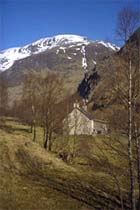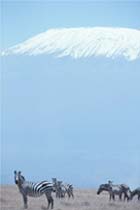
Can you name the world's mountain ranges? Click here to try.

If you would like to join in the talkboard discussion about endangered mountain environments please click here.
If you would like to do some more work on the future of places like Machu Picchu and the Inca Trail or protecting Mount Everest, please click here to see the GEN school project. Your work could win a prize for your school.

Ben Nevis
Mt. Everest
Mt. Kilimanjaro
|
Mountain Factfile
- When two pieces of the Earth's crust smash into each other the land can be pushed upwards, forming mountains.
- The world's highest mountain is Mount Everest in the Himalayan mountains. It is 8,848 metres (29,028 feet) above sea level.
- Everest could get higher - the Himalayan mountains are still growing as two great tectonic 'plates' continue to collide and push upwards.
- Fossils of seashells have been found high up in the Himalayas. This suggests that long ago this land was covered by water.
- The highest 14 mountains in the world are all found in the Himalayas
- The highest mountains in the UK are Ben Nevis, the Cairngorms, Scotland (1344 metres); Snowdon, the Cambrian Mountains, Wales (1085m); Scafell Pike, the Cumbrian Mountains, England (977m) and Slieve Donard, the Mourne Mountains, N.Ireland (852m).
- On average the temperature falls by 6.5 degrees Celsius for every 1000 metres they rise above sea level. The higher you go, the lighter and thinner the air becomes.
- Even mountains on the equator can have snow on their peaks all year e.g. Mt.Kilmanjaro (Tanzania)
- Many mountain ranges are home to rare plants and animals. These environments are especially fragile as a result of human interference.
|
|
People and Mountains
Few people live in the world's highest mountain ranges where it can be very cold and very exposed. However, thousands of people visit them to see the spectacular scenery, rare plants, animals and birds, historic sites and remains of ancient civilisations. Others undertake expeditions to walk or climb the highest and most challenging peaks e.g. Mount Everest.
Many of these mountain areas have something else in common. Often found in very remote areas, few people were able to get to them. Many of these once inaccessible places are becoming easier (and cheaper) to get to, putting these fragile areas at risk from too many visitors.
Mountains v Money
It is becoming cheaper and easier to visit the world's most remote and inaccessible places like the Amazon Rainforest or Antarctica, and some of the world's highest mountains such as Mount Everest, Nepal. This has created tension between those who want to preserve such areas and those who want to make money from them.
For many of the world's poorest countries (which geographers call LEDCs = Less Economically Developed Countries) tourism is a very important way of making money. The more tourists they can attract, the more money they can make. However, too many visitors can cause damage to the very area they have come to see. Many of the world's most remote and spectacular mountain landscapes are beginning to suffer from the effects of too many visitors. Machu Picchu, in the Andes,Peru and Mount Everest, in the Himalayas, Nepal are the two examples you can discover more about.





